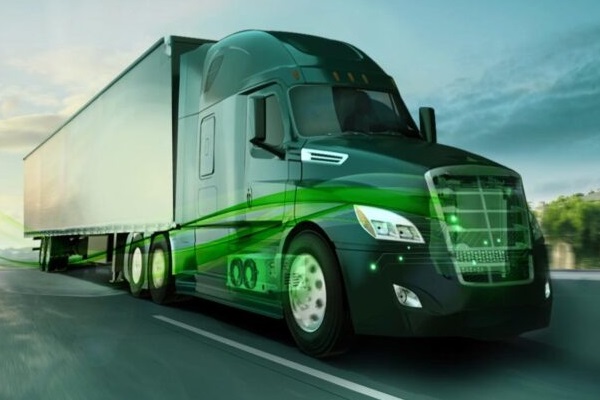
By Gina Bonini, VP and General Manager of Advanced Thermal Systems at Modine
March 27, 2024
For seasoned commercial vehicle operators, winterizing a diesel-powered work truck is like riding a bike – routine and familiar. However, as e-mobility technology continues gaining traction in the commercial vehicle market, operators navigate uncharted territory when preparing electric vehicles (EVs) for cold-weather operation. EVs have requirements for wintertime operation that are somewhat different from those of their diesel counterparts, necessitating a departure from traditional winterization practices.
Regulating the temperature of EV batteries, traction motors, and other electronic components is essential for reliable EV operation in icy environments. In freezing temperatures, battery capacity can decrease as chemical reactions within batteries slow down, leading to increased internal resistance and diminished vehicle range. Additionally, frigid conditions can prolong battery recharge times.
 Given that commercial EVs are inherently designed to be productive assets, ensuring optimal battery performance is crucial for consistent performance. Thankfully, vehicular thermal management is well-established, and industry suppliers are adapting technology and innovations in high-fidelity temperature control to accommodate EV components. As a result, electrified commercial fleet vehicles are viable across ever more market segments and in the most severe environments.
Given that commercial EVs are inherently designed to be productive assets, ensuring optimal battery performance is crucial for consistent performance. Thankfully, vehicular thermal management is well-established, and industry suppliers are adapting technology and innovations in high-fidelity temperature control to accommodate EV components. As a result, electrified commercial fleet vehicles are viable across ever more market segments and in the most severe environments.
Thermal Management in The Electric Era
Despite being one of the least visible components, thermal management is one of the most critical EV systems since temperature impacts vehicle range, charging time, and battery life expectancy. To deliver optimal performance, an EV battery pack must be kept within a specific temperature window during charging and operation, typically 20°C to 45°C (68°F to 113°F).
A battery thermal management system (BTMS) is essential to regulating heating or cooling based on the battery pack’s operating temperature, given ambient temperature. For instance, during a cold winter day, the BTMS will pre-condition the vehicle by warming the coolant circulating the battery pack, ensuring it remains within the ideal temperature range.
 Thermal management is essential for all contemporary EVs, including passenger cars. However, e-buses, off-highway machinery, and other heavy-duty applications usually require dedicated, active systems. When devising a thermal management system for commercial EVs, addressing factors such as spatial constraints and maintaining peak efficiency in rigorous environments is crucial.
Thermal management is essential for all contemporary EVs, including passenger cars. However, e-buses, off-highway machinery, and other heavy-duty applications usually require dedicated, active systems. When devising a thermal management system for commercial EVs, addressing factors such as spatial constraints and maintaining peak efficiency in rigorous environments is crucial.
Moreover, a fundamental aspect of BTMS design for heavy-duty vehicles involves balancing temperature control with power consumption, ensuring that work vehicles attain the reliability of their diesel-powered predecessors while also delivering the range required to get the job done.
Winterizing EVs Beyond BTMS
While a BTMS can operate seamlessly in winter, fleet managers and drivers both play important roles in maximizing efficiency and uptime in cold conditions. In freezing weather, most electric vehicles maintain approximately 70 percent of their range, mainly because of the energy consumed by cabin heating to provide comfort for the driver and passengers.
 Mitigating this loss is simple: prioritize low-power comfort functions like heated seats and steering wheels and turn them off when the vehicle is not in use. Additionally, a consistent connection to charging infrastructure, especially in cold weather, significantly benefits commercial EVs. Plugging in between work cycles, even when batteries are not fully depleted, allows the BTMS to maintain optimal battery pack temperature and reduce extreme fluctuations.
Mitigating this loss is simple: prioritize low-power comfort functions like heated seats and steering wheels and turn them off when the vehicle is not in use. Additionally, a consistent connection to charging infrastructure, especially in cold weather, significantly benefits commercial EVs. Plugging in between work cycles, even when batteries are not fully depleted, allows the BTMS to maintain optimal battery pack temperature and reduce extreme fluctuations.
Storage conditions are another critical factor that can affect battery health and longevity. Vehicles stored in heated or insulated spaces require less time to warm up, ensuring commercial EVs are ready for deployment sooner. Moreover, indoor storage can shield batteries from the detrimental effects of extreme external temperatures, minimizing degradation over time.
Adapting to the Elements
With the country’s southern regions usually warming up before the midwestern and northern ones, road-fairing commercial vehicles must frequently endure a wide range of ambient operating temperatures. Depending on the time of year, a standard semi-truck can cover about 500 miles in just 11 hours, which could take a driver from icy Detroit, Michigan, to sunny Nashville, Tennessee.
A sophisticated BTMS will maintain optimal battery temperature in the cold and provide cooling in the heat, seamlessly adapting to both environments without driver intervention during operation and charging cycles. With automatic management, the transition between cooling and heating is effortless, alleviating the burden of seasonal maintenance for EVs.
 Seasonal upkeep for commercial EVs may differ slightly from traditional internal combustion engines, but fleet managers can streamline this process by prioritizing diagnostic and maintenance software, including thermal management systems. Commercial EVs should be equipped with intuitive tools for fleet owners that assist with routine maintenance and quick troubleshooting.
Seasonal upkeep for commercial EVs may differ slightly from traditional internal combustion engines, but fleet managers can streamline this process by prioritizing diagnostic and maintenance software, including thermal management systems. Commercial EVs should be equipped with intuitive tools for fleet owners that assist with routine maintenance and quick troubleshooting.
By proactively monitoring EV sub-systems, using the right software, and adhering to EV maintenance schedules, fleet owners can ensure year-round reliability for their electric assets no matter the climate—and not all that different from the realm of diesel engines.




